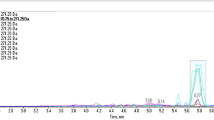Abstract
Background
Methadone maintenance treatment is a widely used therapy in the rehabilitation of opioid addiction the world over. Methadone is metabolised in the body to a number of inactive metabolites, but primarily to 2-ethylidene-1,5-dimethyl-3,3-diphenylpyrrolidine (EDDP). The Division of Forensic Toxicology and Drug Abuse (DFTDA) of the Norwegian Institute of Public Health carries out drug analysis of urine samples from inmates of prisons throughout Norway. Methadone and EDDP in the urine are also tested for upon request. The results are stored in a secure database at the DFTDA.
Objectives
The aims of the present study were (1) to observe variations in methadone and EDDP concentrations in urine in relation to urine pH in a large set of urine samples obtained from prison inmates and (2) to analyse samples testing methadone-positive/EDDP-negative and investigate whether such results could occur naturally, without sample tampering.
Methods
All urine samples that tested positive for methadone over the period 2004–2005 were collected from the DFTDA database, and the relation between methadone and EDDP excretion in urine, and urinary pH was determined. Samples that tested positive for methadone but negative for EDDP were picked out and studied individually.
Results
A total of 1539 urine samples (cases) had tested positive for methadone in our database for the period 2004–2005. There was a strong correlation between the concentration of methadone in urine and urine pH in these samples, with higher concentrations of methadone present at lower pH levels. Cases that tested positive for methadone but negative for EDDP were rare – a total of five (0.3% of all cases tested). These cases were studied in more detail.
Conclusion
Methadone excretion in urine is dependent on urinary pH. Methadone-positive/EDDP-negative results may suggest sample tampering in some, but not all, cases.





Similar content being viewed by others
References
Baselt RC, Casarett LJ (1972) Urinary excretion of methadone in man. Clin Pharmacol Ther 13:64–70
Bellward GD, Warren PM, Howald W, Axelson JE, Abbott FS (1977) Methadone maintenance: effect of urinary pH on renal clearance in chronic high and low doses. Clin Pharmacol Ther 22:92–99
Darke S, Sims J, McDonald S, Wickes W (2000) Cognitive impairment among methadone maintenance patients. Addiction 95:687–695
Dole VP, Nyswander ME (1966) Rehabilitation of heroin addicts after blockade with methadone. N Y State J Med 66:2011–2017
Eap CB, Buclin T, Baumann P (2002) Interindividual variability of the clinical pharmacokinetics of methadone: implications for the treatment of opioid dependence. Clin Pharmacokinet 41:1153–1193
Fiellin DA, O’Connor PG, Chawarski M, Pakes JP, Pantalon MV, Schottenfeld RS (2001) Methadone maintenance in primary care: a randomized controlled trial. JAMA 286:1724–1731
George S, Braithwaite RA (1999) A pilot study to determine the usefulness of the urinary excretion of methadone and its primary metabolite (EDDP) as potential markers of compliance in methadone detoxification programs. J Anal Toxicol 23:81–85
George S, Parmar S, Meadway C, Braithwaite RA (2000) Application and validation of a urinary methadone metabolite (EDDP) immunoassay to monitor methadone compliance. Ann Clin Biochem 37:350–354
Iribarne C, Berthou F, Baird S, Dreano Y, Picart D, Bail JP, Beaune P, Menez JF (1996) Involvement of cytochrome P450 3A4 enzyme in the N-demethylation of methadone in human liver microsomes. Chem Res Toxicol 9:365–373
Katchman AN, McGroary KA, Kilborn MJ, Kornick CA, Manfredi PL, Woosley RL, Ebert SN (2002) Influence of opioid agonists on cardiac human ether-a-go-go-related gene K(+) currents. J Pharmacol Exp Ther 303:688–694
Kiang TK, Ho PC, Anari MR, Tong V, Abbott FS, Chang TK (2006) Contribution of CYP2C9, CYP2A6, and CYP2B6 to valproic acid metabolism in hepatic microsomes from individuals with the CYP2C9*1/*1 genotype. Toxicol Sci 94:261–271
Kirchheiner J, Muller G, Meineke I, Wernecke KD, Roots I, Brockmoller J (2003) Effects of polymorphisms in CYP2D6, CYP2C9, and CYP2C19 on trimipramine pharmacokinetics. J Clin Psychopharmacol 23:459–466
Kornick CA, Kilborn MJ, Santiago-Palma J, Schulman G, Thaler HT, Keefe DL, Katchman AN, Pezzullo JC, Ebert SN, Woosley RL, Payne R, Manfredi PL (2003) QTc interval prolongation associated with intravenous methadone. Pain 105:499–506
Maremmani I, Pacini M, Cesaroni C, Lovrecic M, Perugi G, Tagliamonte A (2005) QTc interval prolongation in patients on long-term methadone maintenance therapy. Eur Addict Res 11:44–49
Marsch LA (1998) The efficacy of methadone maintenance interventions in reducing illicit opiate use, HIV risk behavior and criminality: a meta-analysis. Addiction 93:515–532
Mintzer MZ, Copersino ML, Stitzer ML (2005) Opioid abuse and cognitive performance. Drug Alcohol Depend 78:225–230
Moody DE, Alburges ME, Parker RJ, Collins JM, Strong JM (1997) The involvement of cytochrome P450 3A4 in the N-demethylation of L-alpha-acetylmethadol (LAAM), norLAAM, and methadone. Drug Metab Dispos 25:1347–1353
Nilsson MI, Widerlov E, Meresaar U, Anggard E (1982) Effect of urinary pH on the disposition of methadone in man. Eur J Clin Pharmacol 22:337–342
Oda Y, Kharasch ED (2001) Metabolism of methadone and levo-alpha-acetylmethadol (LAAM) by human intestinal cytochrome P450 3A4 (CYP3A4): potential contribution of intestinal metabolism to presystemic clearance and bioactivation. J Pharmacol Exp Ther 298:1021–1032
Pirnay S, Borron SW, Giudicelli CP, Tourneau J, Baud FJ, Ricordel I (2004) A critical review of the causes of death among post-mortem toxicological investigations: analysis of 34 buprenorphine-associated and 35 methadone-associated deaths. Addiction 99:978–988
Saxon AJ, Whittaker S, Hawker CS (1989) Valproic acid, unlike other anticonvulsants, has no effect on methadone metabolism: two cases. J Clin Psychiatry 50:228–229
Acknowledgments
Many thanks to Karen Sofie Engelstad and Terje Hammer for their invaluable help with data-handling.
Author information
Authors and Affiliations
Corresponding author
Rights and permissions
About this article
Cite this article
Bernard, JP., Opdal, M.S., Karinen, R. et al. Relationship between methadone and EDDP (2-ethylidene-1,5-dimethyl-3,3-diphenylpyrrolidine) in urine samples from Norwegian prisons. Eur J Clin Pharmacol 63, 777–782 (2007). https://doi.org/10.1007/s00228-007-0314-4
Received:
Accepted:
Published:
Issue Date:
DOI: https://doi.org/10.1007/s00228-007-0314-4




